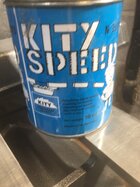Would there be any issue using a car wax on the lathe bed. I see a lot of people using paste wax which SC Johnson apparently does not manufacture anymore.
-
Congratulations to John K. Jordan winner of the June 2025 Turning Challenge (click here for details) -
Congratulations to John Shannon"Cherry Bowl" being selected as Turning of the Week for June 30 2025 (click here for details) -
Welcome new registering member. Your username must be your real First and Last name (for example: John Doe). "Screen names" and "handles" are not allowed and your registration will be deleted if you don't use your real name. Also, do not use all caps nor all lower case.
You are using an out of date browser. It may not display this or other websites correctly.
You should upgrade or use an alternative browser.
You should upgrade or use an alternative browser.
Car wax on lathe bed?
- Thread starter Rob Gabel
- Start date
I use Minwax finishing wax on mine, it's similar to the Johnson paste wax. Some automotive waxes contain silicone which can cause problems with finishing.
I've used car wax on the lathe without any issues, but in my experience, it doesn't work as well as the Johnson did.
I use Microcrystalline Wax on my lathe and not had any issues. I put it on the paintwork as well to help protect it from any accidental spills.
Over here in the UK they sell Machine Wax. I’m not sure exactly what it is but it looks very similar to Microcrystalline wax.
Over here in the UK they sell Machine Wax. I’m not sure exactly what it is but it looks very similar to Microcrystalline wax.
I'd say as long as the auto wax contains no silicone (just a bad idea to have silicone in a wood shop due to problems it causes wood finishes), you'll be fine.
Wax from plants (carnuba), wax from bugs (beeswax), and wax from crude oil (paraffin), take your pick. Anything else they add to the wax is a solvent, or a microabrasive to help polish a surface during wax application. 99.9% of whatever wax you apply to a surface (car hood, coffee table, lathe bed) gets removed as you buff it off properly afterward. Carnuba is the hardest, and highest melting temp, of the 3 general waxes we'd have in our workshops.
Wax from plants (carnuba), wax from bugs (beeswax), and wax from crude oil (paraffin), take your pick. Anything else they add to the wax is a solvent, or a microabrasive to help polish a surface during wax application. 99.9% of whatever wax you apply to a surface (car hood, coffee table, lathe bed) gets removed as you buff it off properly afterward. Carnuba is the hardest, and highest melting temp, of the 3 general waxes we'd have in our workshops.
For a machine that requires resistance tor a sliding part to perform the task, wax is counter intuitive in my opinion. A spritz of WD40 and a wipe down with a Scotchbrite pad is what I have been doing for decades. If you don't plan on using the lathe for a while, let a film of WD40 sit on it. Also decades ago, Ellsworth promoted letting your bed rust for more grip on the tailstock.
I've used automotive wax on the bed to aid in positioning the banjo. However I prefer a bit of Renaissance (microcrystalline) wax - wax on, wax off with a cloth.
I have had zero problems with anything sliding when I didn't want it to slide. My lathe has good clamps.
I have had zero problems with anything sliding when I didn't want it to slide. My lathe has good clamps.
For a machine that requires resistance tor a sliding part to perform the task, wax is counter intuitive in my opinion. A spritz of WD40 and a wipe down with a Scotchbrite pad is what I have been doing for decades. If you don't plan on using the lathe for a while, let a film of WD40 sit on it. Also decades ago, Ellsworth promoted letting your bed rust for more grip on the tailstock.
I periodically apply wax to the lathe bed and on the underside of the banjo and tailstock. This allows the banjo and tail stock to glide nicely on the bed but doesn’t prevent them locking into place as usual.
I sprayed WD40 onto a milling machine table one winter many years ago, mistakenly expecting it to protect it. When I went out into the workshop two weeks later the table was covered in rust. Never again.
Agreed- good clamping, and that doesn't mean overtightening the clamps, have never been bothered by wax application on my old Jet mini, 3 different size Vicmarcs, and a Oneway 1224. Again, 99.9% of the wax is wiped back off. In reality, the wax, WD40, Boeshield, etc. is probably more placebo effect. I think the greater likelyhood is that the metal-on-metal surfaces are clean of sticky tree goo and dirt. Heck, 409 cleaner, Simple Green, etc., and a rag will probably result in improvement of the rest and tailstock movement as much as anything else mentioned here. And I've never done anything to the tables on 2 bandsaws, my former table saw, nor my drill presses. In a climate controlled shop, like mine, rust has never been part of the conversation on any raw cast iron surface. Summer- window AC set at 70, also controls humidity. Winter- 5000 watt (30-amp circuit) electric unit heater hanging from the ceiling maintaining about 63-64. Both benefit from a little 9" fan on the floor at one end blowing up 45 degrees to keep the conditioned air circulating. My shop is single car garage size, a hair over 200sq ft. But I've gone off topic, sorry.I've used automotive wax on the bed to aid in positioning the banjo. However I prefer a bit of Renaissance (microcrystalline) wax - wax on, wax off with a cloth.
I have had zero problems with anything sliding when I didn't want it to slide. My lathe has good clamps.
I use Veritas Tool Wax from Lee Valley. It's a microcrystalline wax designed to reduce friction and prevent corrosion on tools.
I think the greater likelyhood is that the metal-on-metal surfaces are clean of sticky tree goo and dirt.
When I get any finish, glue, gunk on the lathe bed I clean it off with an old cabinet scraper, then rub on a little microcrystalline wax.
Graphite powder on the bedways and banjo shaft about once a month.
Takes only a minute or two.
Apply with a cloth and disposable glove....then toss the glove.
That banjo will slide with one finger!
Try it.....you'll be glad you did!
=o=
Takes only a minute or two.
Apply with a cloth and disposable glove....then toss the glove.
That banjo will slide with one finger!
Try it.....you'll be glad you did!
=o=
Odie, is their any messiness between application cycles of the graphite? Does it continually come off from hand touching or anything else in contact with the bed?
Odie, is their any messiness between application cycles of the graphite? Does it continually come off from hand touching or anything else in contact with the bed?
I haven't had any problems with "messiness" but I never have my hands on the bedways anyway. I'd imagine if you rub your hands on the bedways, you might see some. All I can say is, if a few of you try the graphite, you won't go back to using a paste wax.
Note: I was using a paste wax last century.....until someone else suggested the graphite.....then there was no turning back after that!
=o=
I keep a jar of paraffin dissolved in mineral spirits for protecting cast iron and steel. The formula is simple: dissolve paraffin shavings in mineral spirits until no more will dissolve. An acid brush lives in the jar for small applications and a bit of paper towel spreads a light coat on large surfaces. When the mineral spirits have evaporated from the surface, I wipe down with a clean paper towel. I do not have a problem with the tailstock moving.
All I can say is, if a few of you try the graphite, you won't go back to using a paste wax.
I think I'll try that.
I have a tube of extremely finely powdered graphite with a felt applicator left over from when I rebuilt a player piano action decades ago. (the wooden slides, govenors, some felt, metal-to-wood pivots, and such are often lubricated with graphite - never oil, silicone, etc. Doesn't take much.) Never thought of using it on metal-to-metal contacts.
If not careful it will go everywhere. It does leave a nice, dark, glossy sheen - just now wondering how it would look rubbed on the surface of wood or texture highlights!
JKJ
So, on the subject of waxing or using graphite on the ways. What do all of you guys use to protect the ways from finish and the like? I've used some strips of cardboard, but that gets unruly and problematic rather quickly, and I seem to have run out of cardboard that will do the trick. I usually use a paste wax for my ways, although I might try some graphite as the paste wax doesn't give me one-finger banjo capability, which sounds really nice! (Banjo on the PM3520C is pretty wide and can be a bit unruly to move around just by its locking lever.) However, I find that I all too readily ruin that waxed surface all too quickly when I'm finishing (even when I do have cardboard, keeping it in place over the banjo and between the head and tailstocks, is sometimes a chore, too.)
I seem to have run out of cardboard
I know a possible source of high quality, free, card stock, white on one side, a calendar printed on the other. Our area credit union gives out calendars at the end of every year, two sizes. By March, everyone who wants some has them so I stop in and ask and they give me what's left over. This is card stock, similar to good quality poster board. maybe over 100 weight based on a quick thickness measurement. At the moment I have a lifetime supply.
Last year they gave me a box of 500 sheets of 8.5"x11",
and four boxes of 150 sheets each sheet 22"x28".
(One box of big calendars was 3 years out of date but they hated to just throw them in the trash.)
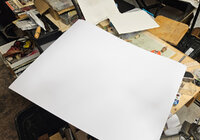
I use these a LOT. The big pieces are perfect for covering work surfaces when making messes like rebuilding carburetors, tracing outlines, photographing some things, catching finishes and stains, and making templates.
I use the smaller ones on the lathe bed, to sketch out designs and make notes, plan sequences, make smaller templates, and make drawings to hold up at demos. The cardboard is thick enough the calendar printed on the other side doesn't show through if the light behind isn't too bright. I sometimes just buy poster board but I'm getting cheap as I get older.
For my small squarish platters
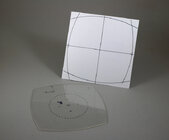
For a handbell ornament demo, before we had cameras and big video screens!
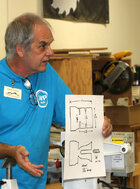
I started getting this stuff from the bank many years ago when teaching kindergarten SS classes - I'd take pieces for kids to draw and color, cut into shapes.
Some public school teachers would get some for their classes.
Maybe check with your local banks and see if they provide similar calendars. Or check with a printing shop - perhaps they have a stack of misprints destined for the dump.
JKJ
I didn't know we were talking about seasonal protection on the lathe bed. WD40 is definitely not good for that. Actually a piece of cardboard works great for that since the condensation will not collect on the cast iron when it is covered.I periodically apply wax to the lathe bed and on the underside of the banjo and tailstock. This allows the banjo and tail stock to glide nicely on the bed but doesn’t prevent them locking into place as usual.
I sprayed WD40 onto a milling machine table one winter many years ago, mistakenly expecting it to protect it. When I went out into the workshop two weeks later the table was covered in rust. Never again.
I'm not a fan if WD40 for any purpose. I bet I haven't owned a can in over 20 years. It's a sub-par lubricant, if at all. Water Displacement, version #40.I didn't know we were talking about seasonal protection on the lathe bed. WD40 is definitely not good for that. Actually a piece of cardboard works great for that since the condensation will not collect on the cast iron when it is covered.
I do have a can of wd40. It works well for removing tape glue off of appliances that have had tape stuck to them. Other than that, it's not very useful.I'm not a fan if WD40 for any purpose. I bet I haven't owned a can in over 20 years. It's a sub-par lubricant, if at all. Water Displacement, version #40.
I have been using graphite for years. I like Odie, rarely touch the bed itself. But I live in Utah where it's dry, so I have little problems with rust anyway.
I'm not a fan if WD40 for any purpose. I bet I haven't owned a can in over 20 years. It's a sub-par lubricant, if at all. Water Displacement, version #40.
I use it sometimes for milling and tapping aluminium on my milling machine.
I don’t doubt that graphite works well as a lubricant on the lathe bed/banjo (I keep a bottle of graphite for my locks), but wax serves two purposes for me.
It not only works as a lubricant but also helps protect against rust and spills, I doubt graphite will work as well for that. As mentioned I use Microcrystalline Wax all over the lathe, including the paintwork.
Last edited:
I think I'll try that.
I have a tube of extremely finely powdered graphite with a felt applicator left over from when I rebuilt a player piano action decades ago. (the wooden slides, govenors, some felt, metal-to-wood pivots, and such are often lubricated with graphite - never oil, silicone, etc. Doesn't take much.) Never thought of using it on metal-to-metal contacts.
If not careful it will go everywhere. It does leave a nice, dark, glossy sheen - just now wondering how it would look rubbed on the surface of wood or texture highlights!
JKJ
Sounds interesting JKJ......
The felt applicator might even be better than a rag. Let us know how it works out for you.
Also let us know where to find it...
=o=
WD-40 from Wikipedia (for what that's worth)- https://en.wikipedia.org/wiki/WD-40
"Jack of all trades..."
"Jack of all trades..."
I use Glidecoat on the ways after cleaning with WD40 and wiping down with alcohol.
- Joined
- Nov 3, 2008
- Messages
- 19
- Likes
- 29
I’ve been using this for many years now. It’s a mix of wax and graphite. I keep a cloth applicator in the can and do a quick wipe down of the ways and banjo only. Follow up with a wipe down w paper towel. This gives me the easy one hand control that I want when positioning the banjo. I don’t remember where I bought it.Graphite powder on the bedways and banjo shaft about once a month.
Stainless steel ways are a real luxury.
Attachments
I generally don't mess with my lathe bed. My old PM 3520A had a nice dark patina when I sold it. My Vicmark is getting that same black patina. I did buy a case of "Butcher's" wax, and they had 2 types, a bowling alley wax and a general purpose wax. I do use glide cote some times, and WD 40, mostly to keep the tool rest from rusting into place. I don't worry about the cast iron getting a patina to it. If it feels too crusty, I do hit it with one of the grey scotch brite pads. Kiwi neutral shoe polish is carnauba wax and a little turpentine, which is what the Butcher's wax smells like. It would also work.
robo hippy
robo hippy
A darkroom developing tray. I still have a bunch in various sizes, from small to quite large, from when I had a wet darkroom and they're endlessly useful!What do all of you guys use to protect the ways from finish and the like?
Kiwi neutral shoe polish is carnauba wax and a little turpentine.
robo hippy
I have some of this. It smells nice and puts a good gloss on wood.
...wet darkroom and they're endlessly useful!
Getting way off topic... A darkroom guy, yay! At a quick count I've had 5 darkrooms, mostly processing 35mm film but up to 4x5" with a view camera. I don't think I ever printed anything bigger than about 18x22 but can't remember. I did most of the photograph and all the darkroom processing for the college yearbook one year.
At one time I bought out a complete darkroom plus cameras, backdrops, tripods, and more from woman who's husband had passed away. It was almost free. She just wanted it all GONE.
One of my favorite subjects was the sky. I caught Haley's comet in '85/86, two different nights from the Great Smoky Mtns to show how much it moved in 24 hours - lined up stars in the two negatives in the darkroom. Picture of a picture and from the front page of a local newspaper. Almost always shot Tri-X, bulk loaded.
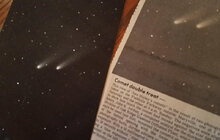
And Comet Hale Bopp, later:

Sunspots during the '17 solar eclipse progression. (I have good solar filters)

Good clean fun!
I eventually got rid of all my darkroom and film stuff except for an old/old darkroom timer (since it was so cool) and a couple of Nikon film cameras. I sure wish I'd saved some of the trays...
JKJ
John, that reminds me of some photos my brother and I took with his 10" reflector and Byers mount some 40 years ago. It was about 25 below in South Dakota that night, but clear. Great for photos. I think it was about a 45 minute exposure. I don't have the picture, but we got a nice one of the M31 globular cluster.
Call your brother - maybe he has a copy of the photo!I don't have the picture, but we got a nice one of the M31 globular cluster.
I should say that although I had the hardware to connect the camera and shoot through the telescope lens, I almost always just piggybacked the camera with lens on a mount on the outside of the telescope - basically just using the scope drive for tracking.
One of my favorite and extremely safe way to view eclipses is by projecting the image with a 4" scope. This is helpful when I set up at schools and churches since lots of kids could see the eclipse at once instead of standing in line for peak through the big scope.
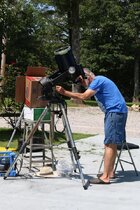

We set up for the '17 eclipse at John Lucas' house - he was right on the center line!
The gentleman I bought my PM3520b from drove down from Maryland just for the eclipse. What an amazing photographer, mostly wildlife.
This is one of Charlie's shots.
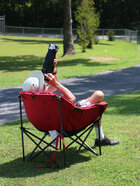

Yikes, I must be the king of getting off-topic.
How about that car wax, eh?
JKJ
I’ve used carnauba car wax without any issuesWould there be any issue using a car wax on the lathe bed. I see a lot of people using paste wax which SC Johnson apparently does not manufacture anymore.
In the UK Axminster Tools sell their own brand "Machine Wax" . It contains no silicones and can be used on cast iron and aluminium. A little goes a long way and it is useful not only for lubrication but also to stop rusting/corrosion during the winter months.
Sounds interesting JKJ......
The felt applicator might even be better than a rag. Let us know how it works out for you.
Also let us know where to find it...
=o=
I bought my graphite maybe 40 years ago from a player piano company that sold supplies, parts, etc. for rebuilding and repair.
An aside on rebuilding on the very slight chance anyone on a woodturning forum is interested:
I rebuilt the piano I my brothers and sisters played on as kids, a non working player. I moved it from PA to TN in a U-Haul trailer and completely rebuilt the works over the period of about a month - what an incredible mind-expending experience!
A initial difficult thing was to get the piano into the basement where I built a workbench for rebuilding the action. Had to remove a picture window, build a wooden support, and pass the piano through the hole on its back with the help of 5 other people. Works like new now!
The technology in these is amazing - and we think of ourselves as technically advanced. The mechanism works entirely on vacuum pressure, foot-operated vacuum pumps, vacuum reservoir, vacuum motor, speed control and regulator, even vacuum edge-detection sensors and actuators to dynamically adjust the position of the paper roll as it changes dimensions with the humidity. Double-action leather vacuum valves detect the weak vacuum from a hole in the paper roll and create a powerful vacuum to operate the 66 little striker bellows to move the piano hammers - and it was capable of a rep rate of multiple times per second. There was even a control to shift the paper roll to play in a different key! I located a player piano mentor a few hours away and he was kind enough to spend a day imparting wisdom. He strongly advised me to use NOTHING but hot hide glue to fasten wood to wood - he said if modern wood glues were used there would be almost impossible for the next person to rebuild it 75 years later.
Besides rebuilding the action, I replaced all the bellows cloth, installed new felts, hammers, strings, tuning pins, etc. Learned how to tune a piano. We've since moved the piano from place to place and it's still plays well today - it currently resides in a son's house in Greeneville, SC. I'm sure EVERYONE knows you can buy new player piano rolls today, some of popular modern music. There are even special mechanical "recording" pianos that punch the paper rolls as you play!
Graphite is widely used in player pianos - no other lubrication is permitted. Also used in non-player pianos, for example to lubricate the top of bridges, key pivots, more.
I couldn't find the company I bought it from but a quick google search gave me this:
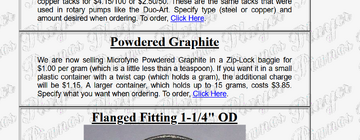
Player Piano Parts and Supplies
Player Piano Parts and Supplies Available at Player-Care.com
I see Amazon sells it:https://www.amazon.com/dp/B09JYMDPB4
I couldn't find the same kind of applicator I have. Mine is a tube, remove the cap and there's a felt end on the tube. Shake the tube to put more on the felt from inside.
Could probably put a bit in a salt shaker, hold a piece of felt on the end, and give a gentle shake.
I've used this graphite several times in the shop but I'm getting elderly and feeble-minded and can't remember what I last used it for! I do remember it is slippery and could be messy.
Another option that might work as well and maybe not be so messy is the white PTFE dry lubricant powder (used to be called Teflon powder). We often add this to lubricating oil, shake well before use. I should try that on a lathe bed and report back.
JKJ
BTW - Don’t use graphite to lube lock cylinders. Years ago, one of my patients who own a large locksmith shop told me that he has been called out to fix lock cylinders that graphite was used in because it packed and the pins would eventually stick. Only light machine oil is appropriate.
I’m just the messenger but I took him at his word.
I’m just the messenger but I took him at his word.
I go back and forth between WD-40 and some lubricant/anti-corrosion spray I got from Amazon in a green can (can't remember the name offhand). After a heavy session with green walnut, I'll scrub down with mineral spirits and 0000 steel-wool, then buff in some Johnson's Paste Wax (which I'm almost out of. I'll miss it like I miss Formby's Tung Oil after it was discontinued years ago).
I might have to give graphite a try; I've got a tube somewhere around here.
I might have to give graphite a try; I've got a tube somewhere around here.
Thank you, Webb. As of this moment, I am retiring my little squeeze tube of graphite powder from lock service. Forunately I haven't used it for this too many times, and pretty lightly when I did.BTW - Don’t use graphite to lube lock cylinders. Years ago, one of my patients who own a large locksmith shop told me that he has been called out to fix lock cylinders that graphite was used in because it packed and the pins would eventually stick. Only light machine oil is appropriate.
I’m just the messenger but I took him at his word.
I get this. I tried lubing the spindle on a very nice Orvis fly reel with graphite, and it just locked it up until I cleaned it out.BTW - Don’t use graphite to lube lock cylinders. Years ago, one of my patients who own a large locksmith shop told me that he has been called out to fix lock cylinders that graphite was used in because it packed and the pins would eventually stick. Only light machine oil is appropriate.
I’m just the messenger but I took him at his word.

